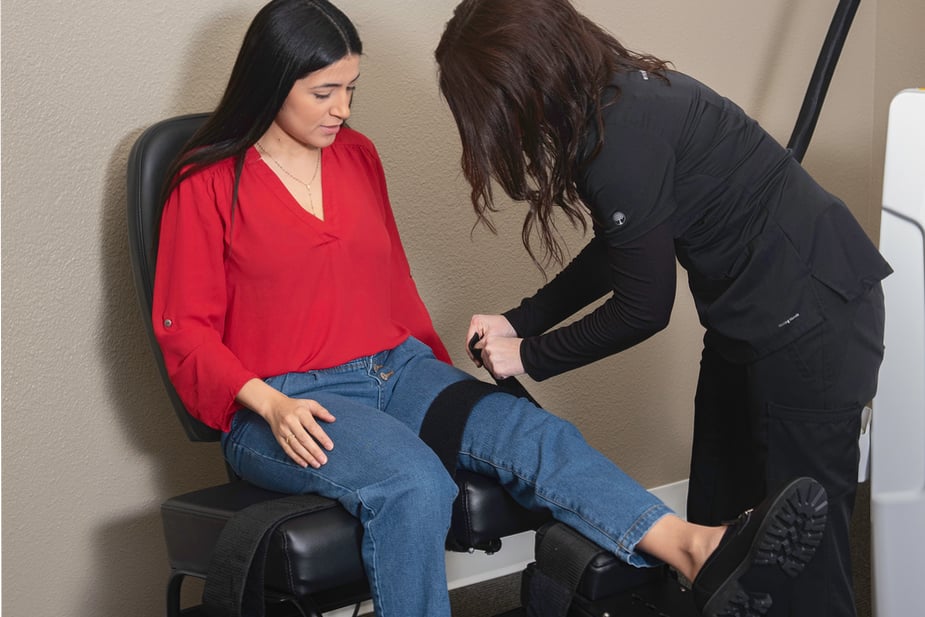What Can a Chiropractor Do About My Nagging Knee Pain?
3 min read

A lot of us live with knee pain that just doesn’t seem to get better, especially as we get older. However, we don't necessarily have to just endure it. A chiropractor can help with common causes of knee pain.
Common Causes of Knee Pain that A Chiropractor Can Treat
Here are come of the most common causes of nagging knee pain that a chiropractor can help with:
Arthritis of the Knee
Our knees are particularly prone to wear and tear, which results in wearing down the cushion inside in the joint. Knees are often one of the first joints to become painful from osteoarthritis as we get older. Arthritic knees tend to ache whether you’re sitting or standing, they can swell when under strain and may also be stiff when you first get up in the mornings.
Bursitis of the Knee
Bursitis is inflammation of a fluid-holding sac above the joint. It can affect any joint, but the bursa on top of the kneecap is particularly vulnerable because of its location. People who repeatedly bend or kneel are most at risk, which is why it is sometimes called "housemaid's knee" or "preacher's knee." You can help prevent bursitis by using padding to protect your knee when you kneel.
IT Band Syndrome
There's a strip of tissue from your hip to your knee called the iliotibial band. This can be inflamed by overdoing activity, with the most common culprit being running downhill too much. Going downhill, surprisingly, puts more strain on your knees than uphill. Runners and hikers are at the most risk for this injury.
Osgood-Schlatter Disease in the Knees
This used to be called "growing pains" and is seen in children and teenagers. It causes pain just below the knee that can come and go over time, and is aggravated by exercise or kneeling. It affects boys and girls equally, and is caused by imbalances that happen when the bones and tendons grow at different speeds.
Patellar Tendinitis
Patellar tendinitis is inflammation in the tendon connecting the kneecap to the shinbone. It's often called "jumper's knee," because it's caused by repetitive jumping. It's a risk factor for basketball and volleyball players because of the amount of jumping involved. The pain is particularly intense if you kneel or squat.
Meniscal Tear
If the cartilage in your knee rips, this can cause rough edges to get stuck in the joint, which feels like a "tug" or "catch" when you bend your knee. In addition to being painful, your knee (or the back of your knee) may swell.
Available Treatments for Ongoing Knee Pain
For some, knee pain will improve with rest. But for some conditions, like arthritis or a meniscus tear, you may only find relief with other types of treatment. As a chiropractor we can help you find out what is the cause of your pain and in many cases, provide treatments that will help you feel better.
Two knee pain treatment options often used at Village Chiropractic are:
1. Cold laser therapy is used often for arthritis and inflammation. It is also particularly good for reducing knee pain caused by tendonitis and bursitis. Cold laser therapy is a non-invasive treatment that does not use any drugs, and can be used in conjunction with other therapies to reduce knee pain and in some cases, can help patients delay or avoid surgery.
You might be interested in reading more in our blog called 3 Benefits of Cold Laser Therapy.
2. Knee Traction. Knee on Trac is a knee traction system that we use to help improve the flexibility and mobility of the knee. This gentle traction increases space in the knee joint and the volume of fluid. It's useful for osteoarthritis in the knee and can also help with pain caused by old injuries that may linger.
If you have nagging pain in your knee, it is worth calling a chiropractor. At Village Chiropractic we will evaluate your knee to find the cause of pain. From there we can recommend treatment options to help you get back on your feet and moving again.
 at our office in The Woodlands.
at our office in The Woodlands.
More from Our Blog on This Topic
7 min read
5 min read





